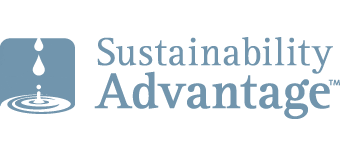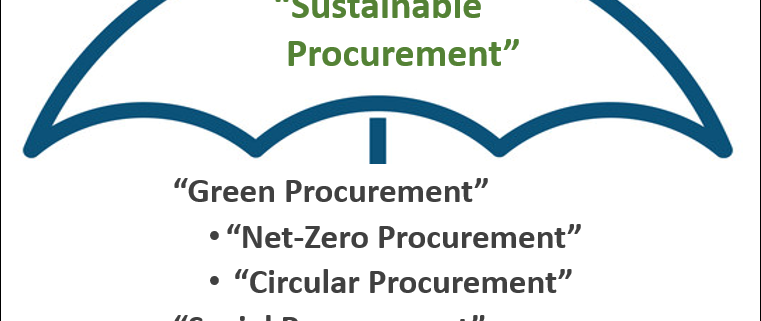Decoding Sustainable Procurement and Its 4 Starter Subsets
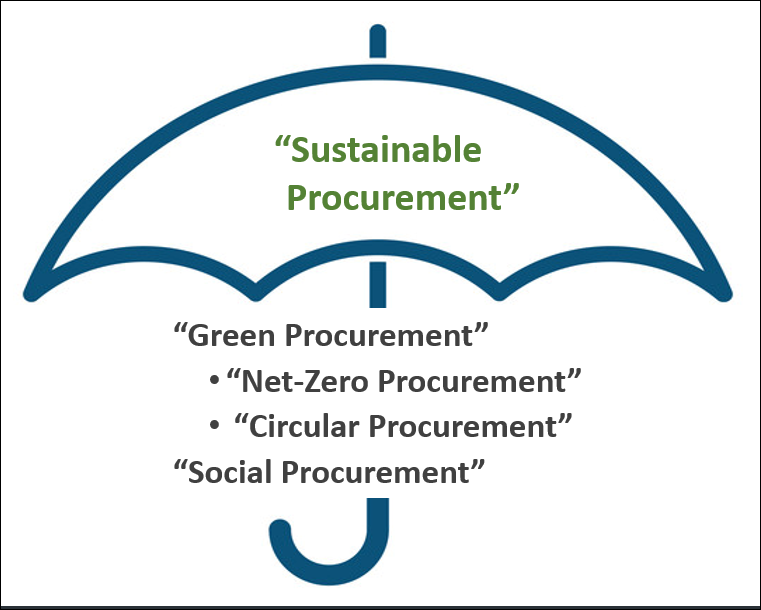
Occasionally, you may find yourself in confusing, even confrontational, conversations about various incarnations of sustainable procurement. Advocates for Sustainable Procurement, Social Procurement, Green Procurement, Net-Zero Procurement and Circular Procurement sometimes appear to be competing with each other. That’s not helpful. We need all of them. To promote collaboration rather than contention, we need to decode Sustainable Procurement and its four starter subsets, and show how they complement each other.
Clear definitions
Let’s start with definitions. The figure below makes it clear that Green Procurement and Social Procurement are the two major subsets of Sustainable Procurement. In turn, Net-Zero Procurement and Circular Procurement are subsets of Green Procurement.
The five definitions in the figure are generic. They apply to procurement in any-size organization, anywhere, in any sector – public sector, private sector, or not-for-profit sector. They use the same parallel, four-part sentence structure to simplify comparisons. The definitions of the four subsets riff off the umbrella definition of Sustainable Procurement.
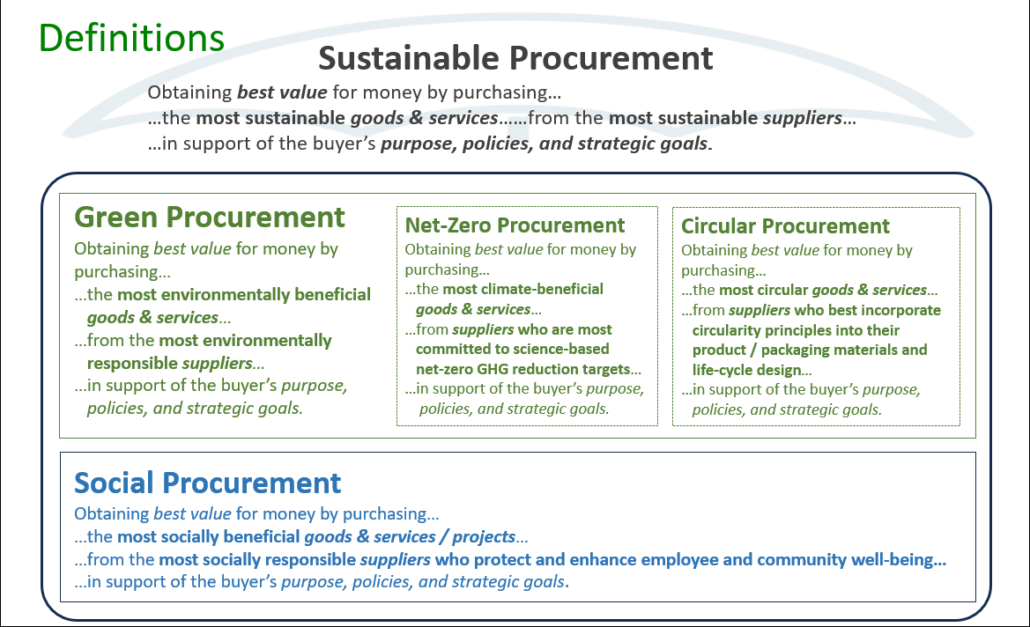
Best value vs lowest price
All definitions start with “Obtaining best value for money …” This intentionally counters the prevalent lowest-price mindset. Understandably, government purchasers want to be good stewards of taxpayers’ money. Corporate purchasers want to reassure shareholders that they are smart, frugal fiduciaries. We need to reassure them that a best-value mindset allows them to be even better stewards and fiduciaries than a best-price predisposition.
When I bought my first electric vehicle, price was an important factor. So were a comfortable ride and instrumentation arrangement. Plus, choosing an EV helped me fulfill my purpose and my strategic goal of achieving net-zero greenhouse gas emissions by 2020. Those qualitative intangibles were important to me and factored into my decision as much as price. They ensured I got best value from my EV purchase.
When purchasing departments acquire goods and services, price should always be an important factor. So should how the acquisition impacts company reputation, environmental wellbeing, employee engagement, and community wellbeing. So should how the transaction helps the company fulfill its purpose and reach its strategic goals. The company wants to be proud of dealing with like-minded, responsible suppliers. These qualitative intangibles are worth something and deserve consideration in the bid appraisal process. They are important to the organization and should be factored into its decision. These don’t need a price tag to matter. They are important considerations and should be weighted accordingly.
Significant weightings = market force
The power of sustainable procurement comes from its weighting. Significant weighting (i.e., 10%-30% of the points) are allocated to the sustainability-related attributes of both suppliers and their goods and services. This causes suppliers to want to win the bid by earning maximum points on these criteria, or at least more than their competitors. Follow the money. Suppliers want to transition to the most sustainable business models and produce the most sustainable goods and services so that they win the revenue. Significant weighting is the signature feature of Sustainable Procurement. It enables it to be a powerful market force supporting the transition to the kind of economy and society we want, as shown in this figure.
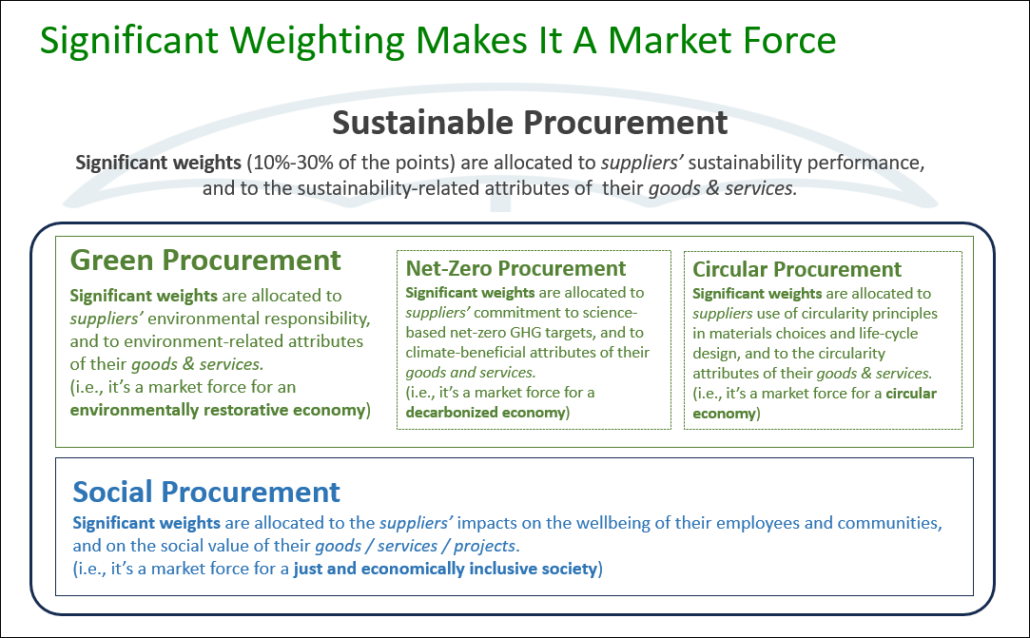
Sustainable procurement respects and builds on current procurement systems
Organizations have carefully evolved their current procurement systems. They are proud of their purchasing processes and certainly don’t want to discard them for some new system. Happily, the four core elements of sustainable procurement (SP) can readily be added to any current procurement system.
- Product attributes: Companies already stipulate quality and performance specifications for goods and services in their requests for proposals (RFPs) or equivalent solicitations. SP simply adds a few sustainability-related specs for the requested goods and services, like energy efficiency, circular design, and eco-labels. These are not instead of the other product specs; they are in addition to them.
- Supplier attributes: Suppliers already disclose their size, sector and experience credentials in their responses to RFPs. SP simply asks them to disclose their sustainability-related performance, as well. The SME-friendly Basic Sustainability Assessment Tool (BSAT), or a tailored version of it, can be used to do this.
- Bid appraisal weightings: Companies already allocate points to product and supplier attributes. SP simply allocates significant weight (i.e., 10%-30% of the points) to the sustainability-related attributes of both suppliers and their goods and services. The remaining points are prorated across the other usual criteria, like price / total cost of ownership, delivery, and warranty.
- Terms and Conditions: Companies already have standard terms and conditions in their contracts with suppliers. SP simply adds a few Ts and Cs that ensure companies live up to their sustainability-related commitments made in the above product and supplier disclosures.
Meet organizations where they are. Build on their current procurement systems. The free, open-source Sustainable Procurement Toolkit has the checklists, assessment tools and templates that expedite the integration of these four core SP elements into any current procurement system. This is not a big-ticket item. Helpful guidance is readily available. It’s a decision.
Start with any subset
Still, integrating all Sustainable Procurement elements into an existing procurement system all at once may seem a bit daunting for some organizations. Any subset – Net-Zero Procurement, Circular Procurement, Green Procurement, or Social procurement – can be used as a starter subset / fractal of a more comprehensive Sustainable Procurement system.
For example, the Net-Zero Procurement Toolkit has the same four core elements as the Sustainable Procurement Toolkit. That is, it has:
- A checklist of suggested product low-carbon, net-zero attributes / specifications
- An SME-friendly Net-Zero Assessment Tool (NZAT) tool to help assess supplier commitment to net-zero greenhouse gas (GHG) targets
- A sample bid appraisal template that heavily weights the low-carbon, net-zero attributes of suppliers and their products
- Suggested Ts and Cs to ensure GHG reduction action
As a bonus, because circular design reduces the carbon footprint of products, the Net-Zero Procurement Toolkit includes Circular Procurement elements.
We are losing the war on climate change. All organizations, especially governments, need to weaponize procurement to win that existential battle. Net-Zero Procurement is the subset that does that. When all suppliers’ commitments to net-zero targets are heavily weighted in bid appraisals, businesses will be strongly incentivized to aggressively reduce their GHG emissions. That’s why, as a father and a grandfather concerned about my family’s future, I lean toward Net-Zero Procurement as the most urgent subset.
Others lean toward Social Procurement, for their good reasons. Both subsets are important and are not mutually exclusive. An organization can start with high priority elements of several starter subsets and weight them appropriately. Then, it can build on that beginning subset mix, and move up the Sustainable Procurement maturity curve. Start small to go big.
The important thing is to start.
Please feel free to add your comments and questions using the “Leave a reply” comment box under the “Share this entry” social media symbols, below. For email subscribers, please click here to visit my site and provide feedback. Slides that explain sustainable procurement and overview the referenced supporting tools are included in the Sustainable Procurement deck in my Master Slide Decks, to which anyone can subscribe.
